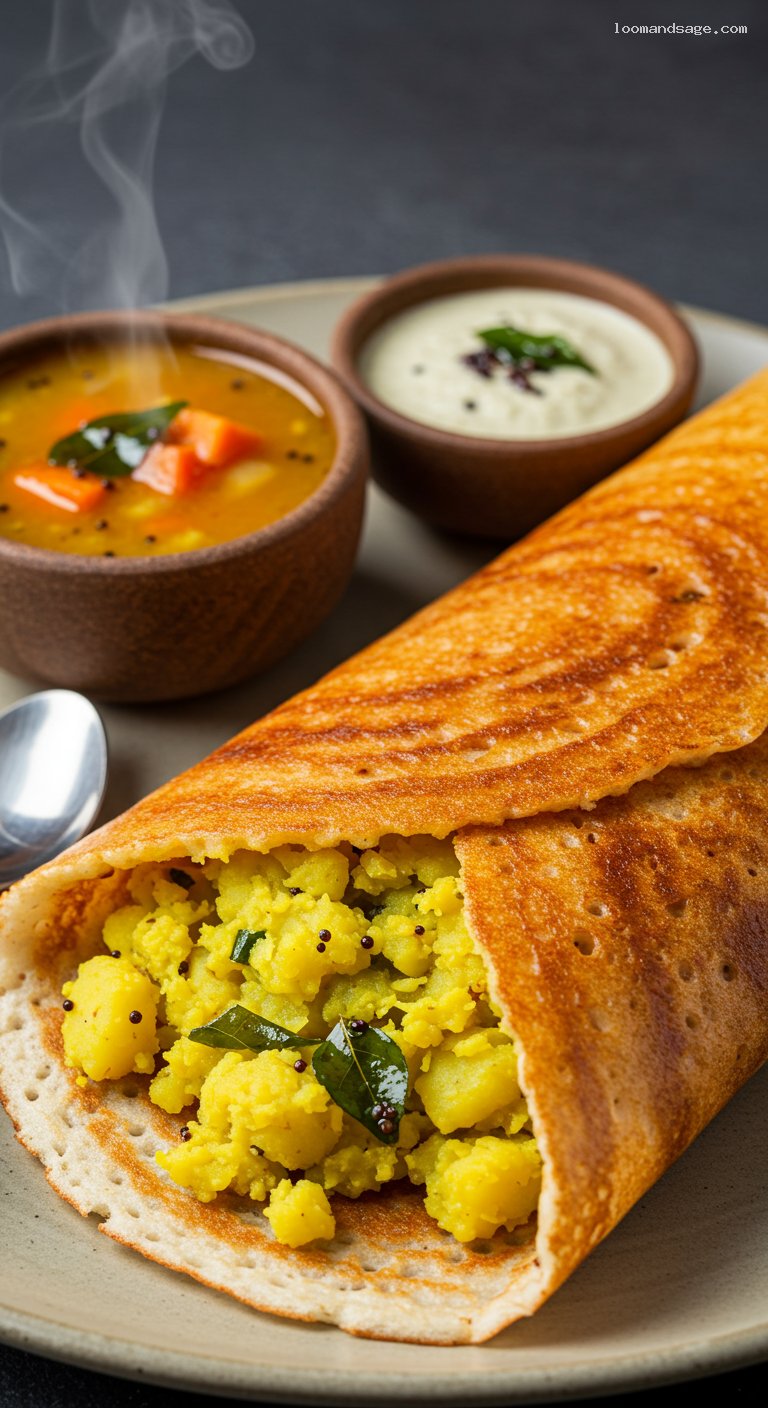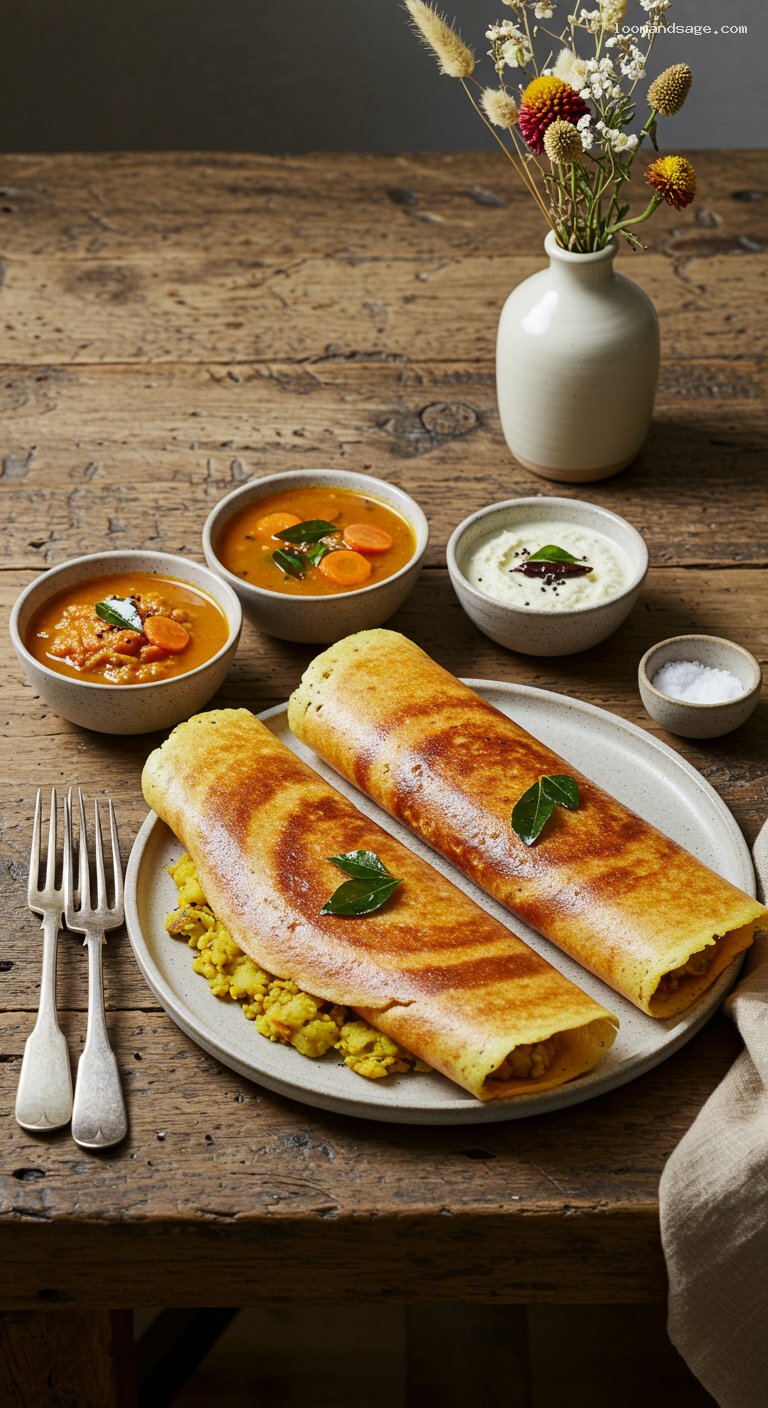Quick Recipe Version (TL;DR)
Quick Ingredients
- Dosa batter: idli/parboiled rice 2 cups (400 g); whole urad dal 2/3 cup (130 g); chana dal 2 tbsp (25 g); fenugreek seeds 1 tsp (3 g); fine salt 1.5 tsp (9 g); water 500–600 ml for grinding
- For cooking dosas: neutral oil or ghee 8–10 tsp (about 1–1.5 tsp per dosa)
- Potato masala: potatoes 1.75 lb/800 g; onion 2 medium (300 g); green chilies 1–2; ginger 1 tbsp (10 g); curry leaves 12; mustard seeds 1 tsp; urad dal 1 tsp; chana dal 1 tsp; turmeric 1/2 tsp; oil 2 tbsp; ghee 1 tbsp optional; lemon juice 1 tbsp; salt
- Sambar: toor dal 1/2 cup (100 g); tomato 1; onion 1/2; carrot 1; eggplant 1 small (optional); turmeric 1/4 tsp; sambar powder 2 tbsp (16 g); tamarind paste 1 tbsp (15 g); salt; oil 1 tbsp; mustard seeds 1 tsp; dried red chilies 2; curry leaves 10; asafoetida 1/8 tsp
- Coconut chutney: fresh grated coconut 1 cup (90 g); roasted chana dal 2 tbsp (20 g); green chili 1; ginger 1/2 inch (5 g); salt; water ~1/3 cup; oil 1 tsp; mustard 1/2 tsp; urad dal 1/2 tsp; curry leaves 6; dried red chili 1
Do This
- 1) Soak rice, dals, and fenugreek separately for 6 hours.
- 2) Grind smooth with 500–600 ml water; combine; ferment 10–14 hours at about 82–86°F (28–30°C) until airy. Salt after fermentation.
- 3) Boil potatoes 12–15 minutes; temper mustard, dals, curry leaves; sauté onions with turmeric and ginger; fold in potatoes, lemon, and salt.
- 4) Pressure-cook toor dal (8–10 minutes) or simmer until soft; simmer with vegetables, sambar powder, tamarind; finish with mustard–chili–curry leaf tempering.
- 5) Blend coconut, roasted chana dal, chili, ginger, salt, and water; temper with mustard, urad dal, curry leaves, dried chili.
- 6) Heat tawa to 425°F/218°C (medium-high). Spread 1/3 cup batter thin, drizzle 1 tsp oil/ghee, cook 2–3 minutes until crisp. Fill with masala, roll, and serve with sambar and chutney.
Why You’ll Love This Recipe
- Restaurant-level crispness with a reliable, home-kitchen-friendly batter ratio and fermentation plan.
- Comforting turmeric potato-onion masala with aromatic mustard seed and curry leaf tempering.
- Balanced plate: tangy, vegetable-rich sambar and fresh coconut chutney for classic South Indian flavors.
- Make-ahead smart: batter keeps for days, and sambar tastes even better the next day.
Grocery List
- Produce: 800 g potatoes, 2 onions, 1 tomato, 1 carrot, 1 small eggplant (optional), green chilies, fresh ginger, 2–3 sprigs fresh curry leaves, 1 lemon, fresh cilantro (optional garnish)
- Dairy: Ghee (optional; use neutral oil for dairy-free)
- Pantry: Idli/parboiled rice, whole urad dal, chana dal, toor dal, fenugreek seeds, sambar powder, tamarind paste, mustard seeds, turmeric, dried red chilies, asafoetida (hing), roasted chana dal (dalia), grated coconut (fresh or frozen), fine salt, neutral oil
Full Ingredients
Dosa Batter
- Idli/parboiled rice: 2 cups (400 g)
- Whole urad dal (skinned black gram): 2/3 cup (130 g)
- Chana dal (split chickpea): 2 tbsp (25 g)
- Fenugreek seeds: 1 tsp (3 g)
- Fine sea salt: 1.5 tsp (9 g), added after fermentation
- Water to grind: 2 to 2.5 cups (500–600 ml), divided
- For cooking: neutral oil or ghee, about 8–10 tsp total
Potato Masala (Filling)
- Potatoes, peeled and cubed: 1.75 lb (800 g)
- Onions, thinly sliced: 2 medium (300 g)
- Green chilies, slit: 1–2 (to taste)
- Fresh ginger, finely minced: 1 tbsp (10 g)
- Mustard seeds: 1 tsp (4 g)
- Urad dal: 1 tsp (5 g)
- Chana dal: 1 tsp (5 g)
- Fresh curry leaves: 12
- Ground turmeric: 1/2 tsp (1.5 g)
- Neutral oil: 2 tbsp (30 ml)
- Ghee (optional, richer flavor): 1 tbsp (14 g)
- Lemon juice: 1 tbsp (15 ml)
- Salt: 1 to 1.25 tsp, to taste
- Water: 2–4 tbsp as needed to loosen
Sambar (Lentil-Vegetable Stew)
- Toor dal (split pigeon peas): 1/2 cup (100 g), rinsed
- Water: 3.5–4 cups total (825–950 ml), divided
- Turmeric: 1/4 tsp
- Tomato, chopped: 1 medium (120 g)
- Onion, chopped: 1/2 medium (75 g) or 6–8 pearl onions
- Carrot, sliced: 1 medium (120 g)
- Eggplant (brinjal), cubed: 1 small (80–100 g), optional
- Sambar powder: 2 tbsp (16 g)
- Tamarind paste: 1 tbsp (15 g) dissolved in 1/2 cup (120 ml) warm water
- Fine salt: 1.25–1.5 tsp, to taste
- Jaggery or brown sugar: 1 tsp, optional
- Tempering: neutral oil 1 tbsp, mustard seeds 1 tsp, dried red chilies 2, curry leaves 10–12, asafoetida 1/8 tsp
Fresh Coconut Chutney
- Fresh grated coconut: 1 cup (90 g)
- Roasted chana dal (dalia): 2 tbsp (20 g)
- Green chili: 1 small
- Fresh ginger: 1/2 inch piece (5 g)
- Fine salt: 1/2 tsp, to taste
- Water: 1/4 to 1/3 cup (60–80 ml), to blend
- Tempering: oil 1 tsp, mustard seeds 1/2 tsp, urad dal 1/2 tsp, curry leaves 6, dried red chili 1, pinch of asafoetida

Step-by-Step Instructions
Step 1: Rinse and soak the grains and lentils
Rinse the rice in several changes of cold water until the water runs mostly clear. Rinse urad dal and chana dal together until water runs clear. Soak rice and fenugreek seeds together in 3 cups (700 ml) water for 6 hours at room temperature. Soak urad dal and chana dal together in 2 cups (475 ml) water for 6 hours. Keep bowls loosely covered.
Step 2: Grind and ferment the batter
Drain both bowls, reserving a little soaking water. Grind urad+chana dal first with 150–200 ml cold water until very light and fluffy (5–7 minutes in a high-speed blender or wet grinder). Transfer to a large nonreactive bowl (room for doubling). Grind the rice+fenugreek with 250–300 ml water to a smooth but slightly grainy paste. Combine both, whisking vigorously for 1–2 minutes to aerate, adding water to achieve a thick pourable batter (like heavy cream). Cover and ferment 10–14 hours at 82–86°F (28–30°C) until the batter has risen by 50–75% and looks bubbly. Tip: Use an oven with the light on or a proofing box. Stir in 1.5 tsp (9 g) salt after fermentation, then thin with 2–4 tbsp water if needed for a ladleable consistency.
Step 3: Make the turmeric potato masala
Boil potatoes in salted water until knife-tender, 12–15 minutes. Drain and lightly crush with a fork (leave some small chunks). Heat a wide skillet over medium heat. Add oil (and ghee, if using). When shimmering, add mustard seeds; when they pop, add urad dal and chana dal and fry 30–40 seconds until lightly golden. Add curry leaves (they will crackle), green chilies, and ginger; sauté 30 seconds. Add onions and turmeric; cook 6–8 minutes until soft and translucent. Fold in potatoes, 2–4 tbsp water to loosen, and salt to taste. Finish with lemon juice. Keep warm on low.
Step 4: Cook the sambar
Pressure cooker method: Combine rinsed toor dal, 2 cups (475 ml) water, and 1/4 tsp turmeric. Cook 8 minutes on high pressure; natural release 10 minutes, then whisk dal until creamy. Stovetop method: Simmer dal with 2.5 cups (600 ml) water and turmeric, partially covered, 35–40 minutes until very soft; whisk smooth.
To the cooked dal add tomato, onion, carrot, and eggplant with 1 cup (240 ml) water. Simmer 10–12 minutes until vegetables are tender. Stir in sambar powder, tamarind water, salt, and jaggery (optional). Simmer 5–7 minutes. For tempering, heat 1 tbsp oil in a small pan over medium heat; add mustard seeds (let them pop), dried red chilies, curry leaves, and asafoetida. Pour the sizzling tempering over the sambar. Adjust salt and tang. Keep hot.
Step 5: Blend the coconut chutney
Blend coconut, roasted chana dal, green chili, ginger, salt, and 1/4–1/3 cup water to a smooth, spoonable chutney. For tempering, heat 1 tsp oil; add mustard seeds (let pop), urad dal, curry leaves, and dried red chili; sauté 30–40 seconds. Stir into the chutney. Taste for salt.
Step 6: Cook crisp dosas
Use a well-seasoned cast-iron tawa or nonstick skillet. Preheat over medium-high until the surface is about 425°F/218°C (water flick should sizzle and evaporate instantly). Lightly wipe with a few drops of oil. Stir the batter gently. Pour about 1/3 cup (75–80 ml) batter in the center and quickly spread outward in spirals with the back of the ladle to a thin round roughly 9–10 inches (23–25 cm). Drizzle 1 to 1.5 tsp oil or ghee around edges and on any thicker spots.
Cook without flipping until the bottom is deep golden with lacy edges, 2–3 minutes. For extra-crisp “paper” edges, lower heat slightly and cook 30–60 seconds more. If the center seems pale, briefly increase heat for the last 20–30 seconds. Loosen edges with a thin spatula.
Step 7: Fill, roll, and serve
Spread 1/2 cup warm potato masala in a line down the center or across one half. Fold or roll the dosa closed. Serve immediately with hot sambar and coconut chutney. Repeat with remaining batter, stirring occasionally and adjusting heat so each dosa cooks evenly. Dosas are best eaten right off the pan while crisp.
Pro Tips
- Fermentation sweet spot: Aim for 82–86°F (28–30°C). If your kitchen is cooler, use the oven light or an Instant Pot on Yogurt (less) with a glass lid.
- Texture check: Batter should be thick yet pourable; too thick gives bready dosas, too thin tears. Adjust a tablespoon of water at a time.
- Nonstick trick: Rub the hot tawa lightly with a cut onion dipped in oil between dosas to keep the surface clean and semi-nonstick.
- Ultra-crisp edges: Spread the batter thin and avoid overloading with oil; a light drizzle plus proper heat gives the signature lace.
- Hing note: Many brands contain wheat. For strict gluten-free needs, use a gluten-free asafoetida or omit it.
Variations
- Mysore Masala Dosa: Brush the cooked dosa side with a thin layer of spicy red garlic chutney before adding the potato masala.
- Ghee Roast Dosa: Use ghee for cooking and cook a touch longer for a glassy, deep-golden, extra-crisp finish.
- Pea Masala: Add 1 cup (130 g) thawed peas to the potato filling in the last 2 minutes for pops of sweetness and color.
Storage & Make-Ahead
Batter keeps 4–5 days refrigerated; it may thicken—stir in 1–2 tbsp water before cooking. Freeze batter up to 1 month; thaw overnight in the refrigerator and stir well. Potato masala keeps 3 days refrigerated; rewarm with a splash of water. Sambar keeps 4 days refrigerated or 2 months frozen; reheat gently and refresh with a few curry leaves. Coconut chutney is best day-of but lasts 1–2 days chilled; thin with water and reblend if it thickens.
Nutrition (per serving)
Approximate: 780 calories; 21 g protein; 108 g carbohydrates; 28 g fat; 12 g fiber; 1,150 mg sodium. Values will vary based on oil used and portion of chutney consumed.


